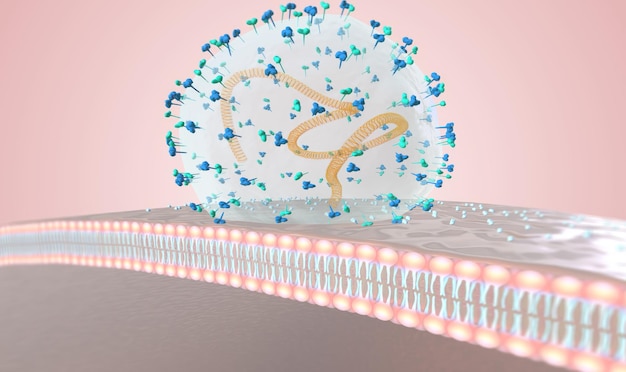Understanding the molecular mechanisms underlying skin stem cell development is crucial for advancing our knowledge of tissue regeneration and repair. In their comprehensive review, Iasonas Dermitzakis, Despoina Dimitria Kampitsi, Maria Eleni Manthou, and colleagues delve into the formative stages of skin stem cells (SCs) and the complex molecular interactions that guide their maturation and functionality. Skin SCs are essential for maintaining the dynamic balance of skin homeostasis, which involves continuous self-renewal and timely differentiation to replace lost or damaged cells. From the earliest phases of embryonic development to the later stages of adult life, different SC populations emerge, each characterized by unique roles in the skin’s architecture, including those in the bulge, interfollicular epidermis, and various skin appendages.
This review illuminates how a finely tuned interplay of signaling pathways ensures the correct development and replenishment of SCs, focusing particularly on how these pathways influence quiescence, activation, and differentiation. It also addresses the consequences of disruptions in these pathways, which can lead to severe conditions such as chronic wounds and skin cancers. Through a detailed analysis of current research, the authors aim to highlight potential therapeutic targets within these molecular mechanisms, offering new possibilities for treating a wide range of skin conditions and enhancing regenerative medicine strategies.
The field of dermatological research has undergone significant advancements in the last few decades, particularly in understanding the skin stem cell development molecular mechanisms. Skin, being the largest organ of the body, serves as the first line of defense against environmental assaults and plays a vital role in physiological homeostasis. The complexity of skin functionality is mirrored in the intricacies of skin stem cell dynamics, which are pivotal in the processes of repair and regeneration following injury or during normal cellular turnover.
Skin stem cells reside in specific niches within the skin, where they remain quiescent until called upon to proliferate and differentiate in response to physiological needs. Historically, the field focused predominantly on defining the cellular constituents of these niches and describing their basic biological functions. Over time, however, attention has shifted towards a more detailed understanding of the molecular underpinnings that govern these functions—particularly the signaling pathways and genetic regulators involved in the development and maintenance of skin stem cells.
At the core of skin stem cell development molecular mechanisms are pivotal pathways such as Wnt, Notch, and Hedgehog, alongside transcription factors like SOX9 and LGR5, which are essential for the regulation of stem cell fate decisions. These factors influence everything from the symmetry of cell division, which determines whether daughter cells become new stem cells or start on a path to differentiation, to the response of stem cells to extrinsic environmental signals.
Moreover, the review from Iasonas Dermitzakis and colleagues emphasizes the delicate balance required in these signaling events. Too much or too little signaling can disrupt the equilibrium of skin homeostasis, leading to skin disorders. The researchers highlight how a disrupted communication can facilitate the development of chronic skin conditions or proliferative disorders such as cancers. This susceptibility underscores the importance of precise molecular control mechanisms in normal stem cell function and the potential for dire consequences when these mechanisms fail.
The study of skin stem cell development molecular mechanisms doesn’t merely cater to academic curiosity but has potent implications for clinical applications. For instance, manipulating these pathways can provide new methods for treating skin injuries or diseases, such as chronic wounds that fail to heal properly, or genetic disorders affecting the skin. Advances in this area offer the tantalizing prospect of novel regenerative therapies that leverage the body’s own cells for effective treatment interventions.
Through these explorations, scientists hope to harness the full therapeutic potential of skin stem cells, paving the way for innovative treatments that can restore function and aesthetics to damaged or aging skin. This underscores the essential need for ongoing research focused on elucidating these complex molecular interactions, holding the promise of transformative impacts on both medicine and quality of life.
In their detailed review of skin stem cell development molecular mechanisms, Iasonas Dermitzakis and colleagues employed a rigorous methodology that systematically analyzed and synthesized findings from a vast array of primary research studies. The aim was to provide a comprehensive understanding of the various molecular interactions and signaling pathways that influence skin stem cell behavior and functionality. This involved a multi-step process to ensure the inclusion of the most relevant and impactful scientific literature in the field.
**1. Literature Collection:** The team began by gathering empirical research articles and reviews published in high-impact, peer-reviewed journals. Databases such as PubMed, Scopus, and Google Scholar were meticulously searched using specific keywords and phrases related to skin stem cell dynamics, such as “skin stem cell activation”, “signaling pathways in skin stem cells,” and “skin stem cell development molecular mechanisms.” This initial step was crucial for capturing a broad spectrum of current and foundational knowledge.
**2. Article Selection and Filtering:** After collecting a considerable volume of literature, the authors used inclusion and exclusion criteria to filter studies based on their relevance to skin stem cell development molecular mechanisms, methodological rigor, and novelty. Priority was given to articles that provided insights into the molecular pathways and mechanisms regulating stem cell fate decisions, responsiveness to environmental signals, and contributions to tissue regeneration and repair.
**3. Data Extraction:** From each selected study, key information was extracted, including the type of skin stem cells examined, the specific molecular pathways involved, genetic factors identified, experimental models used, and the main findings related to stem cell functionality and regulation. This step was critical to understanding how different studies contribute collectively to the wider knowledge field of skin stem cell development molecular mechanisms.
**4. Analysis and Synthesis:** The team then performed a thematic analysis to identify patterns, trends, and gaps in the current research landscape. They synthesized data to map out the complex web of signaling interactions, such as the roles of Wnt, Notch, and Hedgehog pathways and key transcription factors like SOX9 and LGR5, in skin stem cell development and homeostasis.
**5. Review and Evaluation:** The synthesized findings were critically evaluated to assess the strength of the evidence supporting various conclusions and the potential clinical implications of manipulating these pathways in therapeutic contexts.
**6. Reporting:** The final step involved compiling the insights into a structured review that not only delineates the intricate skin stem cell development molecular mechanisms but also highlights potential therapeutic avenues. By elucidating these mechanisms, the review provides a foundational platform for future research and clinical applications aimed at improving regenerative medicine approaches and skin care.
Through this meticulous methodology, the review by Dermitzakis and colleagues stands as a vital resource in the ongoing exploration of skin stem cell biology, opening doors for revolutionary treatments that harness the power of these cells for tissue repair and regeneration. This comprehensive approach ensures that the study contributes effectively to the field’s understanding of the complex molecular mechanisms driving skin stem cell development and functionality.
The review of skin stem cell development molecular mechanisms by Iasonas Dermitzakis and colleagues has revealed several foundational findings about the regulation and functionality of skin SCs. Their analysis underscores the importance of precise molecular control in ensuring skin homeostasis and outlines key pathways and genetic factors that govern stem cell behavior.
**1. Pathway Integration and Stem Cell Functionality:**
One of the pivotal discoveries discussed in the review is the integration of Wnt, Notch, and Hedgehog pathways, which play critical roles in controlling the balance between stem cell quiescence, activation, and differentiation. These pathways, often acting in a context-dependent manner, ensure that stem cells are maintained in a resting state but can rapidly respond to injury or physiological demands by proliferating and differentiating.
**2. Transcription Factors and Stem Cell Fate Decisions:**
The review highlights the significance of transcription factors such as SOX9 and LGR5, which are essential in making stem cell fate decisions. These factors not only regulate the symmetrical or asymmetrical division of stem cells but also influence their ability to respond to external cues. By tightly controlling these aspects, skin stem cells can be directed either to self-renew to maintain the stem cell pool or to differentiate and contribute to tissue repair and regeneration.
**3. Environmental Signals and Stem Cell Responsiveness:**
Another key aspect of the review is the role of extrinsic environmental signals in shaping stem cell behavior. The researchers point out that stem cells reside in niches that provide a specialized microenvironment, where extracellular matrix components, neighboring cells, and localized factors decide how stem cells react to external stimuli. This responsiveness is crucial for adapting to changing physiological conditions and recovering from injury.
**4. Molecular Disruptions and Skin Disorders:**
The review provides critical insight into how disruptions in these molecular mechanisms can lead to skin diseases. Abnormal signaling or mutated transcription factors can disrupt the equilibrium of stem cell behaviors, leading to conditions such as chronic wounds, psoriasis, and even skin cancers. Understanding these disruptions can help in developing targeted therapies that restore normal stem cell function and skin homeostasis.
**5. Therapeutic Potential for Skin Regeneration:**
Significantly, Dermitzakis and colleagues emphasize the therapeutic implications of manipulating skin stem cell development molecular mechanisms. They suggest that by understanding and controlling these mechanisms, novel regenerative therapies can be developed. These therapies might harness the intrinsic power of stem cells to regenerate damaged tissues or treat genetic skin disorders, offering hope for more effective and personalized treatment options in dermatology and regenerative medicine.
By presenting these findings, the review by Iasonas Dermitzakis and colleagues bridges crucial gaps in the current understanding of skin stem cell molecular biology. It establishes a robust framework that not only elucidates the skin stem cell development molecular mechanisms but also flags potential research and clinical directions that could lead to groundbreaking treatments and improved patient outcomes in skin health and disease.
The review of skin stem cell development molecular mechanisms by Iasonas Dermitzakis and his team provides a comprehensive roadmap for the intricate orchestration of pathways and factors essential for stem cell functionality and resilience. As we proceed into the future, it is imperative that the scientific community continues to build upon these foundational insights, further exploring the nuanced interactions within skin stem cells. Advancing our comprehension of skin stem cell development molecular mechanisms holds promising implications, not only for the realm of basic science but also for transformative clinical innovations that could redefine therapeutic approaches in dermatology and regenerative medicine.
Research in the coming years should aim to uncover the potential checks and balances between interconnected signaling pathways such as Wnt, Notch, and Hedgehog. Understanding the crosstalk and the context-dependent nuances of these pathways will offer deeper insights into how stem cells decide between self-renewal and differentiation—crucial for managing stem cell fate in regenerative medicine. Techniques such as single-cell RNA sequencing and CRISPR-Cas9 gene editing have the potential to elucidate the molecular intricacies at an unprecedented resolution, enabling scientists to map the pathways and gene networks with meticulous detail.
Moreover, the role of the microenvironment, or the niche, deserves enhanced focus. Future studies should aim to dissect how extrinsic factors and the physical properties of the microenvironment influence stem cell behavior. This knowledge is vital for creating synthetic niches in vitro that mimic natural conditions for stem cell growth and differentiation for therapeutic purposes. Additionally, with the rise of bioengineering and 3D bioprinting, there lies a potential to create complex, multi-layered skin models that better replicate the dynamic interaction between skin stem cells and their niches.
In clinical applications, a precise manipulation of skin stem cell development molecular mechanisms could lead to advanced treatments for a range of skin conditions. From promoting wound healing in diabetic ulcers to creating new therapeutic avenues for managing devastating conditions like epidermolysis bullosa, the possibilities are extensive. Furthermore, understanding these mechanisms can aid in developing preventive strategies against skin cancer by controlling proliferative signals within stem cell niches.
Lastly, as we delve deeper into the skin stem cell development molecular mechanisms, the ethical considerations become increasingly significant. How we manipulate these potent cells must be guided by strict ethical standards to avoid potential misuse and ensure patient safety at all times.
In conclusion, the review authored by Iasonas Dermitzakis and colleagues not only enhances our understanding of the skin stem cell development molecular mechanisms but also emphasizes the vast therapeutic potential embedded within this knowledge. As the scientific and medical communities forge ahead, the continued exploration of these sophisticated cellular dynamics will undoubtedly pave the way for groundbreaking developments in healing, restoring, and possibly even reshaping the human skin, ultimately improving the quality of life for patients around the globe. Through rigorous research, innovative technology, and ethical vigilance, the future of skin stem cell therapy looks promising, poised to offer novel solutions for complex dermatological challenges.








